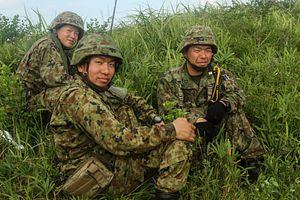The security environment around Japan has become increasingly tense with North Korea’s continued development of nuclear weapons and ballistic missiles, as well as China’s rising power and expansionary military strategy without transparency. In such a situation, the Ministry of Defense (MOD) and Self-Defense Force (SDF) must secure highly qualified personnel that can respond to diversified and internationalized missions.
However, despite rising expectations from the public for the MOD/SDF, the recruitment of uniformed SDF personnel has been a serious challenge. In fact, as of March 31, 2018, the number of authorized positions for uniformed SDF personnel is 247,154, while the actual number is 226,789 — a gap of about 20,000 people and a staffing rate of 91.8 percent. Most recently, the National Defense Program Guidelines for FY 2019 and beyond identified securing human resources for SDF personnel as “an imminent challenge in the face of shrinking and aging population with declining birth rates.” Therefore, it is important to analyze the current situation of population shift in Japan and explore how to reinforce the human resource base in the SDF.
Japan’s aging challenge is serious. The Declining Birthrate White Paper and Annual Report on the Aging Society — both published by Japanese government — elaborate on the urgency that surrounds Japan’s aging and overall population decline. Japan entered a long-term population decline process in 2011 and its population is estimated to decrease to 80.8 million in 2065. The working-age population (15 to 64-years-old) is also projected to decline to 45.3 million by 2065 alongside the decrease of the total population. In contrast, the elderly population (defined as 65 years and older) is estimated to reach 38.4 percent of the total population by 2065. This means one of three Japanese would be over 65.
Given such circumstances, the MOD/SDF has been taking various recruitment measures to mitigate the impact of aging and population decline. For instance, as a measure to better prepare the organization for the shrinking population, the MOD/SDF raised the upper age limit for entrance of new SDF personnel from 26 to 32-years-old in order to expand the recruitment of untenured troops. As a measure to accommodate an aging society, the MOD announced in December 2018 that it would gradually raise the mandatory retirement age of SDF personnel starting in 2020. For example, the current retirement age for colonels and captains is 56, but will be 57 in 2021.
There are other measures that may be worth considering as well. One is introducing different upper age limits for each service. In the United States, for instance, each service has a different enlistment age limit (Marines Corps: 28; Coast Guard: 31; Army: 34; Navy and Air Force: 39). Given that the personnel requirements for the SDF services differ in terms of physical abilities, it is worth considering different age limits for each service like in the United States.
In today’s Japan, the current average length of life for men is 81.1 years and for women is 87.3 years. This is estimated to grow every year and will reach 85.0 and 91.4 years respectively by 2065. The extension of life expectancy indicates that people may be healthier at older ages than before. As the times change and the average life continues to be longer, the MOD should consider further extension of mandatory retirement ages in order to utilize older human resources who have plenty of knowledge, skills, and experience.
It is essential to not only regularly review the implementation status of current measures and make them appropriate, but also create innovative and fresh ideas without Japan’s own stereotypical views. Looking at the situation of declining birthrates and aging populations across Asia, the total fertility rates in Thailand, Singapore, South Korea, and Taiwan are all below the replacement level, like Japan. Researching how these societies secure the human resource base for their defense will be helpful in devising measures for Japan.
Finally, what is important is that the MOD/SDF completes the mission of national defense by strengthening the human resource base. In order to do that, it is necessary to frequently assess whether the current authorized strength of SDF personnel is the proper number to respond to increasing threats around Japan. Although it is difficult to increase the authorized strength of SDF personnel with a limited budget and legal constraints, the MOD/SDF need to look ahead to the changing security environment and cutting-edge military technology and calculate the exact number of personnel required for national defense of Japan.
Yoshimitsu Sato is a Nonresident Fellow with the Japan Program at the Stimson Center. The views and opinions expressed here are of the author only.

































